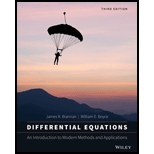
In each of Problems
(a) Determine all critical points of the given system of equations.
(b) Find the corresponding linear system near each critical point.
(c) Find the eigenvalues of each linear system. What conclusions can you then draw about the nonlinear system?
(d) Draw a phase portrait of the nonlinear system to confirm your conclusions, or to extend them in those cases where the linear system does not provide definite information about the nonlinear system.
(e) Draw a sketch of, or describe in words, the basin of attraction of each asymptotically stable critical point.
Want to see the full answer?
Check out a sample textbook solution
Chapter 7 Solutions
Differential Equations: An Introduction to Modern Methods and Applications
Additional Math Textbook Solutions
Elementary Statistics
Basic Business Statistics, Student Value Edition
A First Course in Probability (10th Edition)
Thinking Mathematically (6th Edition)
Algebra and Trigonometry (6th Edition)
- Use 12.4.2 to determine whether the infinite series on the right side of equation 12.6.5, 12.6.6 and 12.6.7 converges for every real number x.arrow_forwarduse Cauchy Mean-Value Theorem to derive Corollary 12.6.2, and then derive 12.6.3arrow_forwardExplain the focus and reasons for establishment of 12.5.4arrow_forward
- Explain the focus and reasons for establishment of 12.5.3 about alternating series. and explain the reason why (sigma k=1 to infinite)(-1)k+1/k = 1/1 - 1/2 + 1/3 - 1/4 + .... converges.arrow_forwardExplain the key points and reasons for the establishment of 12.3.2(integral Test)arrow_forwardUse identity (1+x+x2+...+xn)*(1-x)=1-xn+1 to derive the result of 12.2.2. Please notice that identity doesn't work when x=1.arrow_forward
 Linear Algebra: A Modern IntroductionAlgebraISBN:9781285463247Author:David PoolePublisher:Cengage Learning
Linear Algebra: A Modern IntroductionAlgebraISBN:9781285463247Author:David PoolePublisher:Cengage Learning
